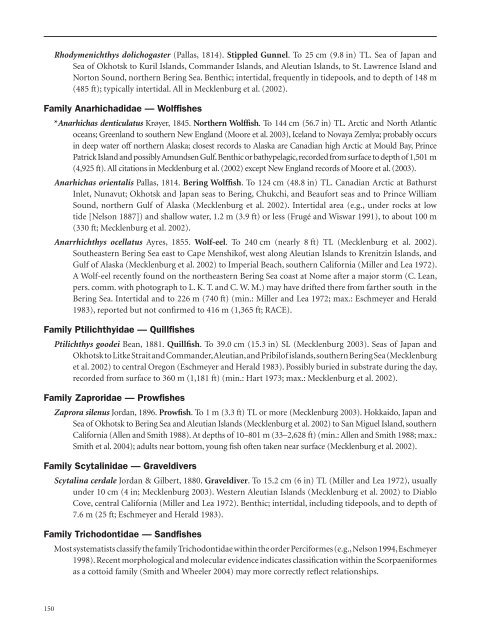Untitled - Alaska Resources Library
Untitled - Alaska Resources Library
Untitled - Alaska Resources Library
Create successful ePaper yourself
Turn your PDF publications into a flip-book with our unique Google optimized e-Paper software.
150<br />
Rhodymenichthys dolichogaster (Pallas, 1814). Stippled Gunnel. To 25 cm (9.8 in) TL. Sea of Japan and<br />
Sea of Okhotsk to Kuril Islands, Commander Islands, and Aleutian Islands, to St. Lawrence Island and<br />
Norton Sound, northern Bering Sea. Benthic; intertidal, frequently in tidepools, and to depth of 148 m<br />
(485 ft); typically intertidal. All in Mecklenburg et al. (2002).<br />
Family Anarhichadidae — Wolffishes<br />
*Anarhichas denticulatus Krøyer, 1845. Northern Wolffish. To 144 cm (56.7 in) TL. Arctic and North Atlantic<br />
oceans; Greenland to southern New England (Moore et al. 2003), Iceland to Novaya Zemlya; probably occurs<br />
in deep water off northern <strong>Alaska</strong>; closest records to <strong>Alaska</strong> are Canadian high Arctic at Mould Bay, Prince<br />
Patrick Island and possibly Amundsen Gulf. Benthic or bathypelagic, recorded from surface to depth of 1,501 m<br />
(4,925 ft). All citations in Mecklenburg et al. (2002) except New England records of Moore et al. (2003).<br />
Anarhichas orientalis Pallas, 1814. Bering Wolffish. To 124 cm (48.8 in) TL. Canadian Arctic at Bathurst<br />
Inlet, Nunavut; Okhotsk and Japan seas to Bering, Chukchi, and Beaufort seas and to Prince William<br />
Sound, northern Gulf of <strong>Alaska</strong> (Mecklenburg et al. 2002). Intertidal area (e.g., under rocks at low<br />
tide [Nelson 1887]) and shallow water, 1.2 m (3.9 ft) or less (Frugé and Wiswar 1991), to about 100 m<br />
(330 ft; Mecklenburg et al. 2002).<br />
Anarrhichthys ocellatus Ayres, 1855. Wolf-eel. To 240 cm (nearly 8 ft) TL (Mecklenburg et al. 2002).<br />
Southeastern Bering Sea east to Cape Menshikof, west along Aleutian Islands to Krenitzin Islands, and<br />
Gulf of <strong>Alaska</strong> (Mecklenburg et al. 2002) to Imperial Beach, southern California (Miller and Lea 1972).<br />
A Wolf-eel recently found on the northeastern Bering Sea coast at Nome after a major storm (C. Lean,<br />
pers. comm. with photograph to L. K. T. and C. W. M.) may have drifted there from farther south in the<br />
Bering Sea. Intertidal and to 226 m (740 ft) (min.: Miller and Lea 1972; max.: Eschmeyer and Herald<br />
1983), reported but not confirmed to 416 m (1,365 ft; RACE).<br />
Family Ptilichthyidae — Quillfishes<br />
Ptilichthys goodei Bean, 1881. Quillfish. To 39.0 cm (15.3 in) SL (Mecklenburg 2003). Seas of Japan and<br />
Okhotsk to Litke Strait and Commander, Aleutian, and Pribilof islands, southern Bering Sea (Mecklenburg<br />
et al. 2002) to central Oregon (Eschmeyer and Herald 1983). Possibly buried in substrate during the day,<br />
recorded from surface to 360 m (1,181 ft) (min.: Hart 1973; max.: Mecklenburg et al. 2002).<br />
Family Zaproridae — Prowfishes<br />
Zaprora silenus Jordan, 1896. Prowfish. To 1 m (3.3 ft) TL or more (Mecklenburg 2003). Hokkaido, Japan and<br />
Sea of Okhotsk to Bering Sea and Aleutian Islands (Mecklenburg et al. 2002) to San Miguel Island, southern<br />
California (Allen and Smith 1988). At depths of 10–801 m (33–2,628 ft) (min.: Allen and Smith 1988; max.:<br />
Smith et al. 2004); adults near bottom, young fish often taken near surface (Mecklenburg et al. 2002).<br />
Family Scytalinidae — Graveldivers<br />
Scytalina cerdale Jordan & Gilbert, 1880. Graveldiver. To 15.2 cm (6 in) TL (Miller and Lea 1972), usually<br />
under 10 cm (4 in; Mecklenburg 2003). Western Aleutian Islands (Mecklenburg et al. 2002) to Diablo<br />
Cove, central California (Miller and Lea 1972). Benthic; intertidal, including tidepools, and to depth of<br />
7.6 m (25 ft; Eschmeyer and Herald 1983).<br />
Family Trichodontidae — Sandfishes<br />
Most systematists classify the family Trichodontidae within the order Perciformes (e.g., Nelson 1994, Eschmeyer<br />
1998). Recent morphological and molecular evidence indicates classification within the Scorpaeniformes<br />
as a cottoid family (Smith and Wheeler 2004) may more correctly reflect relationships.
















